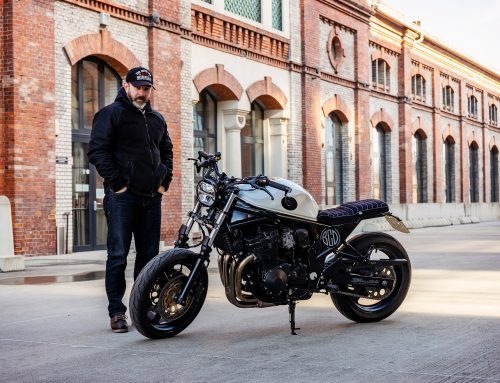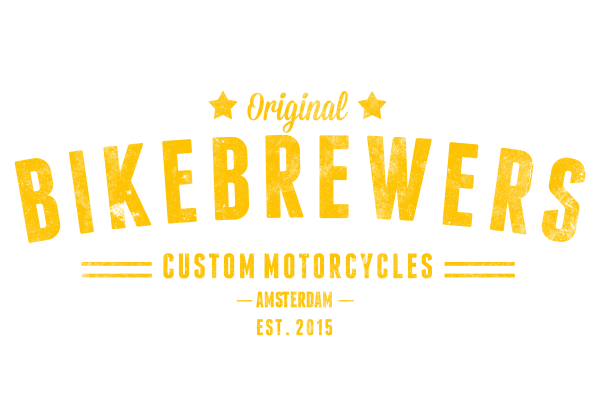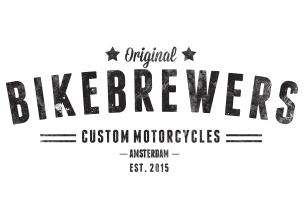Setting the scene
Sometimes in life things come full circle. Allow me to sidestep and take you back. On a sunny day in November 2017, I wanted to unwind from a scientific conference I attended in Miami, Florida. Looking for shade I ended up at Brothers & Brawlers, where I found a beautiful space, an excellent cup of coffee, and an atmosphere that made me want to stay until the end of time. The gray concrete, black steel, and natural wood gave it an industrial vibe, yet the space felt light and leather seats and sofas were soft and pleasant. The helmets, accessories, and garments displayed tickled my fancy. A couple of custom motorcycles were on display. This is what most of us see in our imagination when we hear ‘man cave’. Sebastian Ramirez, owner and founder of DiRocco Eyewear, provided the finishing touch. He set up the space as a living advertisement that you could breathe, smell, and taste.
Inspiration
Next, I saw a motorcycle that planted a seed in my imagination. The seed of building a custom motorcycle (at the time I owned a practically bone stock 2010 Triumph Bonneville T100). As we talked about the space and the concept, a van pulled up. Chet and colleagues jumped out, a bike rolled in. And we ended up giving them a hand in putting it up on a platform for display. The motorcycle was a Triumph Thruxton, designed by a well-known, dapper, masked rider, the first in the Snaefell series by Cohn Racers. Little did I know that 5 years later, I would write about another series of motorcycles the Spanish-born, Miami-based builder Chet P Ilzarbe would produce.
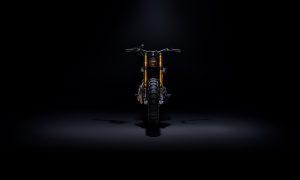
Previously we featured their Harley Davidson XR1200X Muscle R series. Now it is time to update you about their new line, the Muscle R2. In a second part, we will give you more insight into Cohn Racers and its founder.
Background
First, some background. The Muscle R2 came out of the original Muscle R, as most racers and builders can agree: there is always room for improvement. During the production of the original Muscle R, Chet started identifying and testing these small improvements. Adapting, modifying, and testing on a motorcycle one builds for one’s own garage is part of the process. However, this is out of the question when you set yourself high standards for motorcycles you build for clients across the globe. So where can you take these improvements, and express your problem-solving skills? Correct, in a second series, the MR2. The profits from the first series were used to hire Joan Mataro and Anton. The first a mechanical engineer with a passion for motorcycles, the second a carbon fibre specialist, who worked at Scuderia Toro Rosso and Koenisegg. The remaining funds were invested in machinery, including 3D scanners, software and 3D printers. This setup allows for reverse engineering, rapid prototyping, and evaluating data.
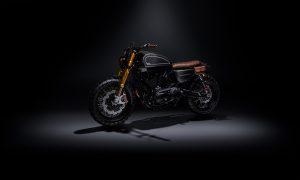
However, despite the improvements in the shop, the original concept remained: a Harley Davidson Sportster with real power, proper brakes, improved handling, and an elegant yet mean stance reflective of its rider. To improve the handling, the team engineered a new frame with optimised geometry for superior comfort and rideability. Secondly, increasing the power output of the engine and decreasing the weight resulted in 26% more horsepower and 22% less weight, further improving both handling and rideability.
Frame
Again, a Sportster model provided the engine and frame as starting points. They 3D scanned both and included an additional XR1200 frame as well. Using the resulting digital mesh with millions of recorded data points, other components could be added digitally. After adding the suspension and wheels, the first prototype was simulated to test behaviour and ergonomics. Several prototypes were then printed from PETG plastic. After several iterations, they settled on a 3-piece assembly that bolts together with four M8 bolts in the front, and four M10 in the back. Master welder Josh Lewis built a welding jig to perfectly align every component prior to assembly. Thus, any alloy can be used to weld up a frame in the perfect geometry. Currently they use Titanium GR5 future MR2 owners. Using these high grade alloys results in a final frame weight of less than half of the original sportster frame.
Weight Savings
Moreover, using Titanium throughout the bike ensures the aforementioned weight savings. The originally steel front and rear axles, head stem, and exhaust are all newly made of titanium. Even the original steel bolts are replaced with titanium bolts. A swing arm of billet cnc aluminium is a piece particularly hard to come by, usually limited to MotoGP and elite racing. Therefore, the team designed a 5-piece that is welded together and adjusted to the client’s height. It provides strength, reduces weight, and introduces just the right amount of flex. Again, digital simulation was used to finetune these parameters into the final design.
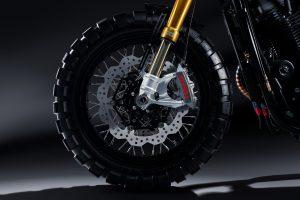
Suspension
Further improving the handling, stock suspension is swapped out for fully adjustable Öhlins FGRT 200 series forks in proprietary cnc billet aluminium triple clamps and dual rear shocks. The spring rate and valving will be adjusted to every client’s specifications.
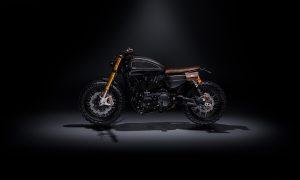
Wheels & Tyres
The stock Harley Davidson hubs spoked with stainless steel and lavcd with 18×6.0 and 18×3.5 rims, give the bike a bit of a flattrack feel. Clients have a wide array of options for tyres with this configuration, yet dual sport tyres seemed to be a popular choice for the first series. Rims made of carbon fibre, titanium, and aluminium are currently under development and will be available as an option only to MR2 owners.

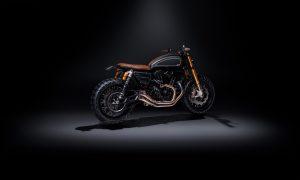
The Powerhouse
Driving all this forward is a 100HP power plant based on the original motor. One of the most challenging parts to engineer and manufacture is the proprietary down draft air intake system. The aluminium manifold is cnc-milled from a solid block on a 6-axis machine. Oxygen is provided via two beautiful mesh covered ducts in the front. Fuel is provided from a laser cut and bent 2mm aluminium sheet that is welded and covered with a carbon fibre shell. A small oil cooler was integrated to reduce oil temperature and the original oil tank under the seat was kept to ensure a sufficient volume in the system. On the back end of the engine are two titanium headers with pie cut bends, giving it a rainbow array of colours after multiple heating cycles, topped off by two Akrapovic exhausts. For future clients willing to trade in some reliability, the output can be increased even further.
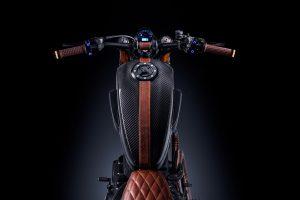
Leatherwork
To sit atop this powerhouse, clients will have to pick their own hide for the handcrafted upholstery. The hides are sourced from Scotland and artisans then craft the seat, tank strap, and optional other parts to ensure unity throughout. This ties both ends together and shows the level of detailing that goes into these bikes!
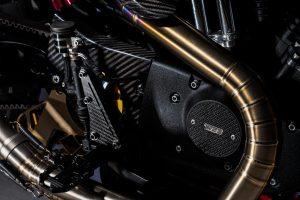
Detailing
Carbon fibre is used throughout the build. Their inhouse specialist with an impressive background has optimised the process of impregnating carbon fibres with resin and curing it in an autoclave (think: industrial pressure cooker) to ensure the optimal resin to fibre ratio. This makes for a very light and simultaneously very strong material. Over 20 parts on the MR2 are made this way. In our eyes, this intensive, expensive process is justified by the outcome! What a visual spectacle to observe!
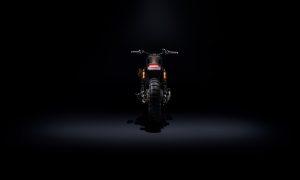
Other aesthetically pleasing details are the lights and indicators. They are fully integrated into the bike. The tail, brake, and indicator lights are integrated into the fender with just two parts! All wiring is carefully hidden from sight, indicator wiring for example is integrated into the handlebars. The gauge is backlit in blue, just as the buttons, a subtle and elegant touch that improves operating them in the dark. This is another indication that the builders prioritised the rider’s point of view. The gauge displays analog revolutions and all other information digitally, keeping it clean and timeless. The front of the gauge is covered with carbon that crowns the bike with a wax mould cast, polished 24K logo.
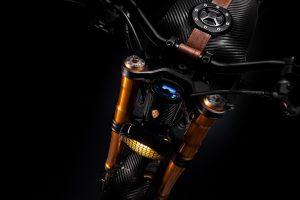
Last call!
Only 99 bikes will be built, according to client specifications. Most of the options that are modified inhouse are included. Adjustments will be made to the ride height, suspension stiffness and other small details that will ensure the most comfortable fit to the client. Special wishes can also be catered for. Pricing is progressive, the first one starting at $45,000 USD.
Do you want to get started? Email
Share This Story, Choose Your Platform!
Tags
Setting the scene
Sometimes in life things come full circle. Allow me to sidestep and take you back. On a sunny day in November 2017, I wanted to unwind from a scientific conference I attended in Miami, Florida. Looking for shade I ended up at Brothers & Brawlers, where I found a beautiful space, an excellent cup of coffee, and an atmosphere that made me want to stay until the end of time. The gray concrete, black steel, and natural wood gave it an industrial vibe, yet the space felt light and leather seats and sofas were soft and pleasant. The helmets, accessories, and garments displayed tickled my fancy. A couple of custom motorcycles were on display. This is what most of us see in our imagination when we hear ‘man cave’. Sebastian Ramirez, owner and founder of DiRocco Eyewear, provided the finishing touch. He set up the space as a living advertisement that you could breathe, smell, and taste.
Inspiration
Next, I saw a motorcycle that planted a seed in my imagination. The seed of building a custom motorcycle (at the time I owned a practically bone stock 2010 Triumph Bonneville T100). As we talked about the space and the concept, a van pulled up. Chet and colleagues jumped out, a bike rolled in. And we ended up giving them a hand in putting it up on a platform for display. The motorcycle was a Triumph Thruxton, designed by a well-known, dapper, masked rider, the first in the Snaefell series by Cohn Racers. Little did I know that 5 years later, I would write about another series of motorcycles the Spanish-born, Miami-based builder Chet P Ilzarbe would produce.

Previously we featured their Harley Davidson XR1200X Muscle R series. Now it is time to update you about their new line, the Muscle R2. In a second part, we will give you more insight into Cohn Racers and its founder.
Background
First, some background. The Muscle R2 came out of the original Muscle R, as most racers and builders can agree: there is always room for improvement. During the production of the original Muscle R, Chet started identifying and testing these small improvements. Adapting, modifying, and testing on a motorcycle one builds for one’s own garage is part of the process. However, this is out of the question when you set yourself high standards for motorcycles you build for clients across the globe. So where can you take these improvements, and express your problem-solving skills? Correct, in a second series, the MR2. The profits from the first series were used to hire Joan Mataro and Anton. The first a mechanical engineer with a passion for motorcycles, the second a carbon fibre specialist, who worked at Scuderia Toro Rosso and Koenisegg. The remaining funds were invested in machinery, including 3D scanners, software and 3D printers. This setup allows for reverse engineering, rapid prototyping, and evaluating data.

However, despite the improvements in the shop, the original concept remained: a Harley Davidson Sportster with real power, proper brakes, improved handling, and an elegant yet mean stance reflective of its rider. To improve the handling, the team engineered a new frame with optimised geometry for superior comfort and rideability. Secondly, increasing the power output of the engine and decreasing the weight resulted in 26% more horsepower and 22% less weight, further improving both handling and rideability.
Frame
Again, a Sportster model provided the engine and frame as starting points. They 3D scanned both and included an additional XR1200 frame as well. Using the resulting digital mesh with millions of recorded data points, other components could be added digitally. After adding the suspension and wheels, the first prototype was simulated to test behaviour and ergonomics. Several prototypes were then printed from PETG plastic. After several iterations, they settled on a 3-piece assembly that bolts together with four M8 bolts in the front, and four M10 in the back. Master welder Josh Lewis built a welding jig to perfectly align every component prior to assembly. Thus, any alloy can be used to weld up a frame in the perfect geometry. Currently they use Titanium GR5 future MR2 owners. Using these high grade alloys results in a final frame weight of less than half of the original sportster frame.
Weight Savings
Moreover, using Titanium throughout the bike ensures the aforementioned weight savings. The originally steel front and rear axles, head stem, and exhaust are all newly made of titanium. Even the original steel bolts are replaced with titanium bolts. A swing arm of billet cnc aluminium is a piece particularly hard to come by, usually limited to MotoGP and elite racing. Therefore, the team designed a 5-piece that is welded together and adjusted to the client’s height. It provides strength, reduces weight, and introduces just the right amount of flex. Again, digital simulation was used to finetune these parameters into the final design.

Suspension
Further improving the handling, stock suspension is swapped out for fully adjustable Öhlins FGRT 200 series forks in proprietary cnc billet aluminium triple clamps and dual rear shocks. The spring rate and valving will be adjusted to every client’s specifications.

Wheels & Tyres
The stock Harley Davidson hubs spoked with stainless steel and lavcd with 18×6.0 and 18×3.5 rims, give the bike a bit of a flattrack feel. Clients have a wide array of options for tyres with this configuration, yet dual sport tyres seemed to be a popular choice for the first series. Rims made of carbon fibre, titanium, and aluminium are currently under development and will be available as an option only to MR2 owners.


The Powerhouse
Driving all this forward is a 100HP power plant based on the original motor. One of the most challenging parts to engineer and manufacture is the proprietary down draft air intake system. The aluminium manifold is cnc-milled from a solid block on a 6-axis machine. Oxygen is provided via two beautiful mesh covered ducts in the front. Fuel is provided from a laser cut and bent 2mm aluminium sheet that is welded and covered with a carbon fibre shell. A small oil cooler was integrated to reduce oil temperature and the original oil tank under the seat was kept to ensure a sufficient volume in the system. On the back end of the engine are two titanium headers with pie cut bends, giving it a rainbow array of colours after multiple heating cycles, topped off by two Akrapovic exhausts. For future clients willing to trade in some reliability, the output can be increased even further.

Leatherwork
To sit atop this powerhouse, clients will have to pick their own hide for the handcrafted upholstery. The hides are sourced from Scotland and artisans then craft the seat, tank strap, and optional other parts to ensure unity throughout. This ties both ends together and shows the level of detailing that goes into these bikes!

Detailing
Carbon fibre is used throughout the build. Their inhouse specialist with an impressive background has optimised the process of impregnating carbon fibres with resin and curing it in an autoclave (think: industrial pressure cooker) to ensure the optimal resin to fibre ratio. This makes for a very light and simultaneously very strong material. Over 20 parts on the MR2 are made this way. In our eyes, this intensive, expensive process is justified by the outcome! What a visual spectacle to observe!

Other aesthetically pleasing details are the lights and indicators. They are fully integrated into the bike. The tail, brake, and indicator lights are integrated into the fender with just two parts! All wiring is carefully hidden from sight, indicator wiring for example is integrated into the handlebars. The gauge is backlit in blue, just as the buttons, a subtle and elegant touch that improves operating them in the dark. This is another indication that the builders prioritised the rider’s point of view. The gauge displays analog revolutions and all other information digitally, keeping it clean and timeless. The front of the gauge is covered with carbon that crowns the bike with a wax mould cast, polished 24K logo.

Last call!
Only 99 bikes will be built, according to client specifications. Most of the options that are modified inhouse are included. Adjustments will be made to the ride height, suspension stiffness and other small details that will ensure the most comfortable fit to the client. Special wishes can also be catered for. Pricing is progressive, the first one starting at $45,000 USD.
Do you want to get started? Email


